Llanfair is a small village situated to the east of the A496 coastal road between Llanbedr and Harlech, about a mile south of Harlech. The men of the village who fell during the Great War are commemorated on a simple war memorial. The men are listed on the memorial in order of date died, but I have re-arranged them into alphabetical order for ease of reading.
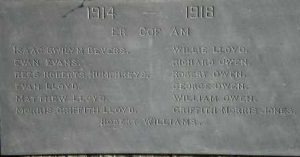
The Great War, 1914-1918
Isaac Gwilym Bevers, Second Lieutenant, Royal Welsh Fusiliers. Isaac was born at Henley, Oxfordshire on 10 May 1893, the son of Walter Bevers and Margaret Bevers (née Evans). Following the death of his father in 1902, the family moved back to Margaret’s native Merionedd, and lived at Trum Orthin, Harlech, near to her home of Llanfair. Isaac was educated at Barmouth School and gained his BSc at Bangor University prior to being commissioned into the Royal Welsh Fusiliers on 14 November 1914. He had served with the regiment at Gallipoli before being invalided home, where he got engaged to Gracie Thomas, of 298, High Street, Bangor. Bevers was posted to Whittington Camp, near Oswestry before being transferred to the 16th Battalion, Royal Welsh Fusiliers. The battalion was by then at Ypres with the 38th (Welsh) Division and on 31 July 1917 took part in the famous assault on Pilckem Ridge, during the opening day of the Third Battle of Ypres. Isaac is listed as having been killed in action on 2 August 1917, but he must have died of wounds suffered during the assault, as he is buried behind the lines in Dozinghem Military Cemetery, Belgium. The 24-year-old was due to go home on leave on the following day, to marry his fiancée, Gracie. Isaac is commemorated on war memorials at Bangor; Bangor University; and at Harlech.
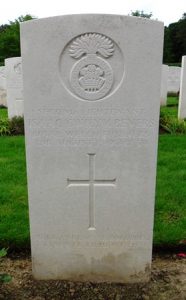
Evan Evans, Corporal, 39185, Royal Welsh Fusiliers. Evan was the son of Griffith and Mary Evans, of Brwynllynau, Harlech. He worked as a farm labourer at Bootle prior to enlisting at Wrexham into the Royal Welsh Fusiliers on 10 December 1915. He was posted to the 3rd Battalion, Royal Welsh Fusiliers at Litherland and after training was posted to the Base Depot in France on 25 October 1916. Initially destines for the 2nd Battalion, RWF, he was instead posted to the 16th Battalion, RWF, which was attached to the 38th (Welsh) Division, and joined the battalion at the Canal Bank positions, north of Ypres on 6 November 1916. The Division held the line here following its move from the Somme earlier in the year, up until launching its assault on Pilckem Ridge, during the opening phase of the Third Battle of Ypres, on 31 July 1917. Following its success at Ypres, the Division was moved to positions near Armentieres to rest, leaving the Ypres sector on 10 September. Evan was promoted corporal soon afterwards. On 19 September 1917 his battalion was in the line near Sailly-Sur-La-Lys when it came under fire from German trench-mortar batteries. Evan was killed in action during the explosion of one of their shells that day. The 24-year-old is buried in Erquinghem-Lys Churchyard Extension, France. Evan is also commemorated on the Harlech War Memorial.
Rhys Roberts Humphreys, Air Mechanic 2nd Class, 109537, Royal Flying Corps. Rhys was born on 4 April 1897, the son of John Evans Humpreys and Elizabeth Humphreys, of Gwynfryn, Llanbedr. He was studying at Oxford when war broke out, and had served with the Officer Training Corps. He was commissioned as a Second Lieutenant into the Welsh Regiment on 30 August 1915 and served for twelve months before being discharged and re-enlisted at Armoury House into the Honourable Artillery Company on 20 October 1916. He served in France from 10 October 1916 until 22 December 1916 before returning to England to be discharged to a commission into the Royal Naval Air Service. He joined the RNAS on 8 April 1917 and was posted to Crystal Palace for training, before joining the RNAS Airship Depot at Wormwood Scrubbs, but went AWOL and was discharged from the RNAS as a result. He then joined the Royal Flying Corps, and was posted to the 35th Training Squadron to train as a pilot. On 15 March 1918, Rhys was undertaking flying instruction aboard a Bristol F.2b, Serial C4647, with Captain Edward Fraser Norris, and was carrying out loops, when the wings folded and the aircraft crashed into the ground at Port Meadow Aerodrome, Oxford, killing both men. Rhys was 21 years old and his remains were brought home for burial in Nazareth Calvinistic Methodist Cemetery, Penrhyndeudraeth.
Griffith Morris Jones, Lieutenant, Westmoreland and Cumberland Yeomanry. Griffith was born at Llanfair on 20 April 1890, the son of the Reverend Robert Jones and Ellen Jones. His father was, at the time, vicar of St. Mary’s Church. He was educated at St John’s College, Ystrad Meurig and at Jesus College, Oxford, graduating BA in 1917. Griffith had enlisted into the Westmoreland and Cumberland Yeomanry in September 1914 and was commissioned as Second Lieutenant on 23 October 1915. He married Elizabeth Cragg, of North Villa, Edentown, Carlisle, that year. Griffith does not appear to have served overseas, but his time in khaki ruined his health and he took ill in the summer of 1918, before being sent to the Pinewood Sanatorium, Wokingham. He was diagnosed as suffering from tuberculosis and was then transferred to the Matlock Sanatorium in Derbyshire, where he died of tuberculosis on 13 December 1918, aged 28. His remains were brought home for burial in St. Mary’s Churchyard, Llanfair.
Evan Lloyd, Private, 291538, Royal Welsh Fusiliers. Evan was the son of John and Mary Lloyd, of Tynymaes, Llanfair. He worked as a bootmaker prior to enlisting at Harlech into the 7th Battalion, Royal Welsh Fusiliers on 23 February 1916, and was then posted to Wrexham Barracks. Evan remained on home service until 4 September 1916 when he embarked for the Middle East and joined the 1/7th Battalion, Royal Welsh Fusiliers at Egypt, where it was attached to 158 Brigade, 53rd (Welsh) Division. The Division had seen action in Gallipoli in 1915 and after being evacuated had joined the EEF in Egypt, helping drive the Turks out of the Sinai and securing the Suez Canal, before taking part in the offensive into Palestine. The coastal city of Gaza was to the north of the canal, and was the centre for the Turkish defensive position in Palestine. On 26 March 1917 the First Battle of Gaza was launched and the 53rd (Welsh) Division was among the attacking forces, attacking the Gaza positions from the south. The day ended in chaos for the EEF, and most of the ground gained was later ceded back to the Turks. Among the many casualties suffered during the days fighting was Evan. He was 21 years old and is commemorated on the Jerusalem Memorial, Israel. Evan is also commemorated on the Harlech War Memorial.
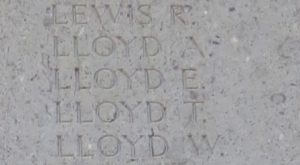
Matthew Lloyd, Private, 27475, King’s Shropshire Light Infantry. Matthew was born at Llanfair in about 1880, the son of David and Jane Lloyd. By the age of eleven he was working as a servant for Morris Jones, at Llanfair. Prior to the war Matthew lived with his wife, Annie Lloyd (nee Pearce), at 14, Totterdown Street, Tooting, where he worked as a dairyman. He enlisted at Cwmparc, Rhondda into the Welsh Regiment, but after training was posted to France where he joined the 1st Battalion, King’s Shropshire Light Infantry. The battalion was attached to 16 Brigade, 6th Division and had been in France since September 1914. Matthew probably joined the battalion early in 1918, possibly in time to take part in the terrible fighting which followed the German Spring Offensive which hit the Somme sector on 21 March 1918. The battered Division then moved to Flanders to rest, but became caught up in the second phase of the German Offensive, which they launched on the Lys Valley on 9 April. The fighting raged for weeks, but German attention then turned to the Champagne sector in May, so the Lys front settled down. During August 1918 the Allies had recovered sufficiently to be able to launch their own attacks on the Germans, and after a brilliant victory at Villers Brettoneux on 8 August, attacks were launched at Albert on 21 August. The 6th Division took part in the Advance in Flanders later that month, before moving south, to take part in the advance on the Hindenburg Line. The 1st KSLI moved from Heilly to Aubigny, in the Somme Valley, on 11 September and three days later arrived at Trefcon, before moving to positions near St. Quentin Wood, to take part in the great offensive. At 05.20 on 18 September the battalion began its part in the offensive, launching an assault towards Fresonoy-le-Petit, as part of the Battle of Épehy. Matthew was killed near Trout Copse six days later, on 24 September 1918, aged 39. He is buried in Chapelle British Cemetery, Holnon, France.
Morris Griffith Lloyd, Private, 61065, Royal Welsh Fusiliers. Morris was born at Brwynllynah, Llanfair in 1892, the son of Edward and Elizabeth Lloyd. His farmer was a farmer, who later bought Byrllysg Farm, Dyffryn Ardudwy. Morris worked on the farm prior to enlisting at Dolgellau into the Royal Welsh Fusiliers, and after training was posted to the 19th Battalion, Royal Welsh Fusiliers, which was attached to 110 Brigade, 40th (Bantam) Division. The Division moved to France during the first week of June 1916, and moved to the front near Loos. Late in 1916 it moved south to the Somme, and fought at the Battle of the Ancre, before wintering in the area. In March 1917 the Germans withdrew to their shortened line, called the Hindenburg Line, and the 40th Division was one of the Divisions that followed the withdrawal. Later in the year it took part in the Battle of Cambrai, playing an important role in the attack on Bourlon Wood. Morris was killed during the terrible fighting in Bourlon Wood on 23 November 1917. The 25-year-old has no known grave and is commemorated on the Cambrai Memorial, Louverval, France.
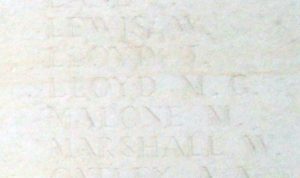
Willie Lloyd, Private, 61111, Royal Welsh Fusiliers. Willie was the son of Ellis and Ann Lloyd, of Bronygadair, Llanfair. He enlisted at Dolgellau into the Royal Welsh Fusiliers, and after completing his training, and early in 1917 was posted to the 16th Battalion, Royal Welsh Fusiliers, which was attached to the 38th (Welsh) Division. The Division had taken part in heavy fighting on the Somme in July 1916, whilst capturing Mametz Wood. It was then relieved, moving to Hébuterne before taking over the Canal Bank sector of the line to the north of Ypres. The Division held this sector for almost a year before launching its assault on the Pilckem Ridge on 31 July 1917, as part of the opening assault of the Third Battle of Ypres, or Passchendaele. The Division’s assault on Pilckem Ridge was a complete success, and part of the Division also fought at Langemarck before the entire Division was relieved, moving to the Armentieres sector for the winter. On 21 March 1918 the Germans launched the first of their three offensives of 1918 against the British on the Somme, and the line was pushed back many miles. The 38th (Welsh) Division was despatched back to the Somme to relieve some the 47th and 2nd Divisions which had suffered heavily there and on 3 April took up positions facing the Bouzincourt Ridge, to the north of Albert. The Germans held the high ground on the ridge, so 113 Brigade was sent in to assault the ridge on 22 April. The attack was a costly success. Willie was wounded during the days fighting and was evacuated to the 3rd Canadian Stationary Hospital at Doullens, where he died of his wounds on the following day, 23 April 1918, aged 19. He is buried in Doullens Communal Cemetery Extension No. 1, France.
George Owen, Private, 3264, Royal Welsh Fusiliers. George was the son of William and Margaret Owen, of Ffordd Groes, Harlech. He worked as a waggoner prior to the war and in 1913 married Elizabeth Jones, before the couple moved to Ty Llewelyn, Nefin. George enlisted at Carnarvon into the 1/6th Battalion, Royal Welsh Fusiliers, which was a Territorial battalion, attached to North Wales Brigade, Welsh Division. The Division moved to Bedford in May 1915 where the formation became 158 Brigade, 53rd (Welsh) Division. On 19 July 1915 the Division sailed from Devonport for Imbros and on 9 August 1915 landed at Suvla Bay, Gallipoli. The Division advanced into the bush, but was ill prepared, with very few maps and no knowledge of the terrain, and as a result the various battalions got lost, with chaos ensuing when the men came into contact with the Turkish defenders. George survived the initial chaotic fighting, but the strain of life at Gallipoli proved too much for him and he died of heart failure on 3 September 1915, aged 23. He has no known grave and is commemorated on the Helles Memorial, Gallipoli. He is also commemorated on the Harlech War Memorial.
Richard Owen, Private, 268071, Royal Welsh Fusiliers. Richard was the son of Richard and Margaret Owen, of Tynllidiart, Llanbedr. He worked as a farm labourer prior to enlisting at Dolgellau into the 5th Battalion, Royal Welsh Fusiliers on 9 September 1915. Richard remained on home service until being drafted to France, embarking on 14 March 1918, and was posted from the Base Depot to the 9th Battalion, Royal Welsh Fusiliers, joining the remnants of the battalion on 29 March. The battalion was attached to 58 Brigade, 19th (Western) Division which had been badly hit following the German Spring offensive on the Somme a week earlier. The Division was withdrawn from the Somme and moved to a more peaceful section of the line near Messines Ridge to rest and rebuild, but on 9 April the Germans launched the second phase of their offensive along the Lys valley, and the 19th Division became caught up in terrible fighting again, before being withdrawn and moved to the Aisne. Again, it was unfortunate, as the third and last phase of the German offensive was launched on the Aisne on 27 May and the Division was again caught up in heavy fighting. The tide of war turned following the combined Australian/ Canadian victory at Villers-Bretonneux from 8 August and on 21 August 1918 the Allies launched their great offensive all along the Western Front. The 19th Division advanced in Northern France and from 4 November took part in the final battle of the war, the Battle of the Sambre. Richard was killed in action on 6 November 1918, during the capture of the village of Bettrechies, whilst advancing towards Maubeuge. The 20-year-old has no known grave and is commemorated on the Vis-en-Artois Memorial, Haucourt, France. His brother Robert also fell. Both men are also commemorated on the nearby Llanbedr War Memorial.
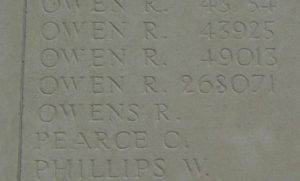
Robert Owen, Private, 15251, Royal Welsh Fusiliers. Robert was the son of Richard and Margaret Owen, of Tynllidiart, Llanbedr. He worked as a farm labourer prior to enlisting at Dolgellau into the 10th Battalion, Royal Welsh Fusiliers. The battalion was originally formed in Wrexham and moved to Codford St. Mary, Salisbury Plain attached to 76 Brigade, 25th Division. On 27 September 1915 Robert landed at Boulogne with the battalion, before 76 Brigade transferred to the 3rd Division at Ypres. By 4 October 1915 the 10th Battalion, RWF had reached its barracks at Bailleul and six days later marched to Poperinghe, coming under command of the 3rd Division, and on 15 October took over trenches in the Ypres Salient for the first time. On 27 November 1915 the battalion was once again in the firing line, when Robert was shot in the head and killed by a German sniper. One of the battalion snipers managed to shoot and kill the German just afterwards. Robert was just 19 years old when he was killed that day and is buried in Hedge Row Trench Cemetery, Belgium. His brother Richard also fell. Both men are also commemorated on the nearby Llanbedr War Memorial.
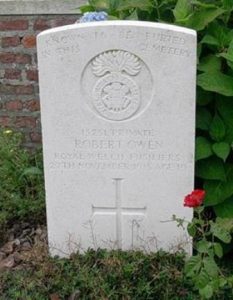
William Owen, Gunner, 13166, Royal Marine Artillery. William was born on 23 May 1890, the son of William and Margaret Owen, of Ffordd Groes, Harlech. He enlisted into the Royal Marines at Bristol on 8 November 1912, under the name of George Owens, and was posted to the RM Barracks at Eastney, where he trained before becoming a gunner with the Royal Marine Artillery. On 10 January 1914 he was posted aboard the battleship HMS Zealandia. Following the outbreak of war, Zealandia was transferred back to the 3rd Battle Squadron of the Grand Fleet. For the next two years she frequently put to sea to search for German vessels, but saw no action during this period. By November 1915, Zealandia was detached to serve in the Gallipoli Campaign, but the peninsula was evacuated by January 1915, so Zealandia returned to Britain, re-joining the 3rd Battle Squadron. William remained aboard her until she was paid off in late 1917 and converted into a gunnery training ship. He then returned to Eastney Barracks. During the summer of 1918, William was taken ill and hospitalised in Portsmouth Royal Naval Hospital. He died there of pneumonia on 21 July 1918, aged 25. William’s remains were conveyed back home for burial in St. Mary’s Churchyard, Llanfair. He is also commemorated on the Harlech War Memorial. His brother George had died at Gallipoli in 1915.
Robert Richard Williams, Private, 315636, Royal Welsh Fusiliers. Robert was born on 4 November 1881, the son of Robert and Laura Williams, of Tyn-Y-Buarth, Llanfair, Harlech. He worked as a boot repairer prior to the war, when he enlisted into the Royal Welsh Fusiliers. Robert was posted to the 23rd Battalion, Royal Welsh Fusiliers, which was a Home Service battalion, based in Norfolk with 224 Brigade, and performed coastal defence duties. Robert died at Cambridge Military Hospital on 5 September 1917, aged 35. His remains were brought home for burial in St. Michael’s Churchyard, Llanfihangel-Y-Traethau. He is also commemorated on the Harlech War Memorial.